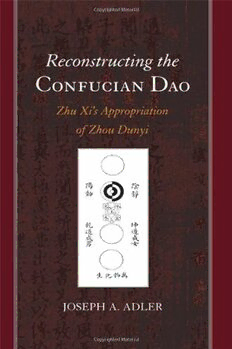
Reconstructing the Confucian Dao: Zhu Xi's Appropriation of Zhou Dunyi PDF
Preview Reconstructing the Confucian Dao: Zhu Xi's Appropriation of Zhou Dunyi
Reconstructing the Confucian Dao SUNY series in Chinese Philosophy and Culture Roger T. Ames, editor Reconstructing the CONFUCIAN DAO Zhu Xi’s Appropriation of Zhou Dunyi JOSEPH A. ADLER State University of New York Press Published by State University of New York Press, Albany © 2014 State University of New York All rights reserved Printed in the United States of America No part of this book may be used or reproduced in any manner whatsoever without written permission. No part of this book may be stored in a retrieval system or transmitted in any form or by any means including electronic, electro- static, magnetic tape, mechanical, photocopying, recording, or otherwise without the prior permission in writing of the publisher. For information, contact State University of New York Press, Albany, NY www.sunypress.edu Production and book design, Laurie Searl Marketing, Michael Campochiaro Library of Congress Cataloging-in-Publication Data Adler, Joseph Alan. Reconstructing the Confucian Dao : Zhu Xi’s appropriation of Zhou Dunyi / Joseph A. Adler. pages cm. — (SUNY series in Chinese philosophy and culture) Includes bibliographical references and index. ISBN 978-1-4384-5157-2 (hardcover : alk. paper) 1. Zhou, Dunyi, 1017–1073. 2. Neo-Confucianism. 3. Zhu, Xi, 1130–1200. I. Title. B128.C44A63 2014 181'.112—dc23 2013025545 10 9 8 7 6 5 4 3 2 1 For Ruth and Anna Contents ix Acknowledgments PART I 3 Introduction 15 Chapter 1: Zhu Xi, Zhou Dunyi, and the Confucian dao 37 Chapter 2: Zhou Dunyi’s Role in the daotong 77 Chapter 3: The Interpenetration of Activity and Stillness 111 Chapter 4: Taiji as “Supreme Polarity” 137 Conclusions PART II: Translations of Zhou Dunyi’s Major Works and Zhu Xi’s Commentaries, with Further Discussions by Zhu Xi and His Students 147 Introduction 151 Chapter 5: The Supreme Polarity Diagram (Taijitu 太極圖) viii Contents 167 Chapter 6: Discussion of the Supreme Polarity Diagram (Taijitu shuo 太極圖說) 203 Chapter 7: Penetrating the Scripture of Change (Tongshu 通書) 299 Chapter 8: Zhu Xi’s Postfaces and Notes 309 Bibliography 323 Index Acknowledgments I remember the precise moment when I began to look into Zhu Xi’s appropriation of Zhou Dunyi. It was in Taipei, in February 1990, and I was sitting in a bare office at National Taiwan University with my hands poised over the keyboard of an old (even at the time) “IBM-compatible” PC. I had not yet decided which of two options to pursue under my Language and Research fellowship at the Inter-University Program in Chinese Language Studies: to revise my dissertation for publication, or to look further into Zhu Xi’s use of Zhou Dunyi’s texts, a topic that I had touched on in the dissertation. Finding the latter more intriguing, I began translating Zhu’s commentary on Zhou’s Tongshu. The work continued sporadically over the intervening two decades, as other writing projects pushed it to the back burner. I am extremely grateful to the Inter-University Program and the Academia Sinica Committee on Scientific and Scholarly Cooperation with the U.S.A. for providing that fellowship. In 1994 I received a grant from the Pacific Cultural Foundation to continue work on the translation (Part II of this book), and in 2008 I received a Scholar Grant from the Chiang Ching-kuo Foundation to support the writing of Part I. For both, and for my 2008–09 sabbatical leave from Kenyon College, I am extremely grateful. I also wish to express my heartfelt thanks to those who provided feedback at various stages of this project: the late Professor Yang Youwei of Taipei, who helped me with the earliest stages of the translation; Kidder Smith Jr. and the participants in the New England Symposium on Chinese Thought at Bowdoin College for their comments in 1992 on my first attempt to make sense of Zhu Xi’s appropriation of Zhou Dunyi (ultimately a dead end); Philip J. Ivanhoe, for his detailed written comments in 1999 on the paper I read at the Association for Asian Studies annual meeting in Washington, D.C. (the first ix
